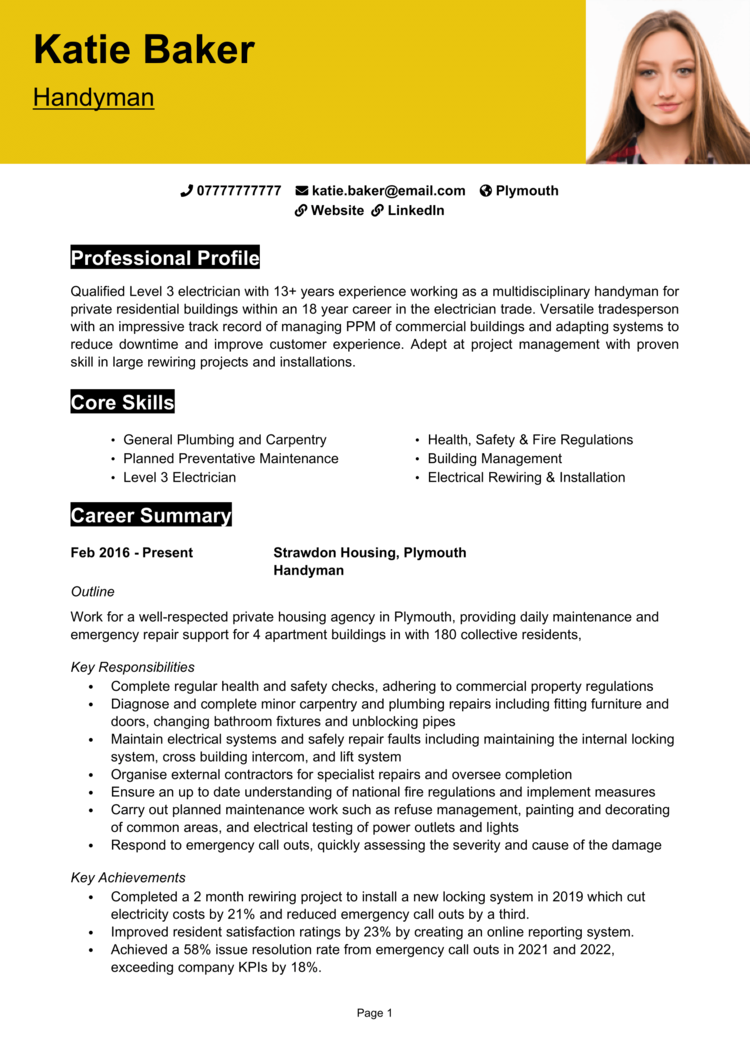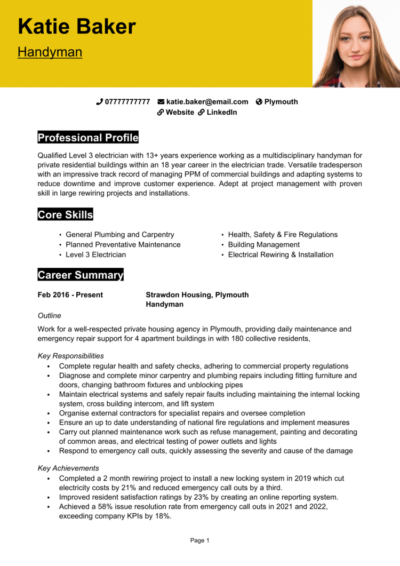Time to hammer out a new CV? Employers want someone reliable and efficient – and your CV is how you prove that before you’ve even opened your toolbox.
This guide and its Handyman example CV will show you how to present your experience clearly, highlight your most valuable skills, and get your foot in the door for better jobs and contracts.
Handyman CV sample

How to write your Handyman CV
Discover how to craft a winning Handyman CV that lands interviews with this simple step-by-step guide.
This guide takes you through each step of writing a CV for a professional and reliable handyman. From organising your layout to showcasing the range of skills you offer – from electrical work to basic carpentry – every section is designed to help you stand out.
Structuring and formatting your Handyman CV


A good CV structure is a bit like a well-done repair – clean and totally functional. Employers should be able to scan it and see right away that you’ve got the skills to keep things running smoothly. Don’t make the mistake of a messy and hard-to-navigate layout: even the most qualified candidates would be overlooked as a result.
Here’s the layout to follow:
- Name and contact details – Place your name and personal details prominently at the top of your CV for quick access. Adding a photo is up to you.
- Profile – Open with a compelling overview of your skills, experience, and career goals.
- Core skills – List your key abilities in this section, focusing on those that will be most relevant to the job.
- Work experience – Provide a detailed breakdown of your work history, starting with the most recent job first, going over responsibilities and achievements.
- Education – List your qualifications, including degrees and relevant certifications, in reverse chronological order.
- Additional info – Use this optional space for relevant hobbies or personal pursuits that enhance your application.
Keep your CV format tidy with professional fonts, use bullet points to lay out your experience clearly, and divide sections with clear, easy-to-spot headings. Keep the document to two pages length max and avoid clutter – your CV should reflect the same neatness and efficiency you bring to your work.
The best way to write a Handyman CV profile


Your profile is a short, sharp introduction at the top of your CV – a place to show you’ve got hands-on skills and practical know-how. Whether you’ve worked in residential maintenance, commercial facilities, or self-employed roles, this is your chance to summarise what you do best. The overall aim is to convince recruiters that you will offer genuine value, and that hiring you would benefit them.
Handyman CV profile examples
Profile 1
Versatile Handyman with over 12 years of experience providing maintenance, repair, and installation services in residential and commercial settings. Skilled in carpentry, plumbing, tiling, and general repairs. Known for delivering reliable workmanship, resolving issues quickly, and maintaining a clean, safe working environment.
Profile 2
Experienced and practical Handyman with eight years of experience supporting property management companies and private landlords. Proficient in carrying out a wide range of tasks, including fixture installation, patch repairs, painting, and basic electrical work. Reliable and responsive, with a strong focus on customer satisfaction and timely service.
Profile 3
Resourceful Handyman with six years of experience working across housing associations and small businesses. Adept at diagnosing faults, managing day-to-day maintenance tasks, and handling minor renovations. Brings a professional attitude, a full set of tools, and a commitment to completing jobs to a high standard.
Details to put in your Handyman CV profile
Make sure your profile includes:
- Where you worked – Whether for a maintenance company, housing association, letting agency, or freelance
- Your top qualifications – Include any relevant certifications, like City & Guilds or a CSCS card
- Essential skills – General repairs, painting, plastering, plumbing, electrics – name your strongest areas
- Types of properties or clients – Residential flats, office buildings, schools, landlords – show the range
- Standout qualities – Mention things like being responsive, punctual, trustworthy, or able to work alone
How to present your core skills section properly


This section gives employers a quick list of what you can do. Just a few bullet points is enough – think of it like a quick job sheet of your top strengths.
Tailor your CV skills to match the job description where possible. If they want someone skilled in carpentry or basic electrics, lead with that. Keep the focus on practical, real-world abilities – no need for buzzwords here.
Key skills that make a Handyman CV stand out
- General Repairs and Maintenance – Performing routine fixes such as patching walls, repairing doors, and tightening fittings.
- Plumbing Repairs – Addressing minor plumbing issues including leaking taps, blocked drains, and toilet repairs.
- Electrical Work – Replacing light fixtures, switches, sockets, and troubleshooting basic electrical faults safely.
- Painting and Decorating – Preparing surfaces and applying paint, wallpaper, or other finishes for interior and exterior projects.
- Carpentry and Joinery – Installing shelves, assembling furniture, repairing cabinets, and handling basic woodwork tasks.
- Appliance Installation and Setup – Fitting and testing household appliances such as washing machines, dishwashers, or cookers.
- Tool and Equipment Use – Operating hand tools, power tools, and maintenance equipment effectively and safely.
- Safety and Compliance Awareness – Following health and safety regulations when carrying out tasks, especially in occupied environments.
- Preventive Maintenance Checks – Identifying potential issues before they become major problems and performing routine inspections.
- Client Communication and Job Scheduling – Discussing job requirements, providing quotes, and scheduling tasks with minimal disruption.
How to present your work experience in your CV


Here’s your chance to show what jobs you’ve done and how you’ve helped keep things running. Whether you’ve worked for a maintenance firm or as a one-man operation, each job should show what tasks you handled and the value you brought.
List your work experience in reverse chronological order. Use bullet points for clarity and focus more detail on recent and relevant work.
And if you’ve taken on ad hoc jobs or short-term contracts, you can still group them together or explain them briefly – just be clear about what you did.
How should you list jobs on your Handyman CV?

- Outline – Start with a quick summary of the role and setting – for example, working across residential properties for a housing association, or carrying out routine maintenance at a private school.
- Responsibilities – Break down your daily tasks using action words like “repaired” and “installed.” For example: “repaired leaking radiators in multi-unit properties” or “installed kitchen units and replaced damaged flooring.” Mention any tools, systems, or types of jobs handled.
- Achievements – Add value by highlighting positive outcomes: fast job turnaround, positive tenant feedback, or reduction in maintenance callouts. Use figures or facts if you can – even “completed 30+ weekly jobs” tells a story.
Work history examples for a Handyman
Handyman | Greyrock Property Services
Outline
Provided general maintenance support to a portfolio of 35 residential properties across London, completing daily reactive and scheduled repair tasks.
Responsibilities
- Repaired damaged fixtures, door locks, windows, and interior fittings
- Performed painting, decorating, and basic plastering following tenant changeovers
- Carried out minor plumbing and electrical tasks such as fixing leaks and replacing sockets
- Responded to urgent maintenance requests, including heating and water issues
- Maintained clear service records and submitted reports to property managers
Achievements
- Reduced maintenance backlog by 40% through improved scheduling and fast resolution
- Praised by tenants and landlords for professionalism and quality of work
- Contributed to a 15% increase in property inspection satisfaction scores
Handyman | Avonhurst Estates
Outline
Handled day-to-day building maintenance across three office sites for a regional facilities management company.
Responsibilities
- Completed basic repairs to furniture, lighting, door frames, and tiling
- Installed shelving, whiteboards, and workstations for new employees
- Carried out routine checks on HVAC filters, fire doors, and emergency lighting
- Worked with contractors to escalate complex electrical and plumbing issues
- Ensured work areas remained clean, hazard-free, and in line with safety procedures
Achievements
- Reduced outsourced maintenance costs by £10k annually by handling more work in-house
- Completed office refurbishment projects 2 weeks ahead of schedule
- Recognised by facilities manager for dependable, flexible support across sites
Handyman | Self-employed
Outline
Provided handyman services to private clients, local businesses, and landlords, covering minor repairs, improvements, and odd jobs.
Responsibilities
- Carried out carpentry, basic plumbing, garden fencing repairs, and furniture assembly
- Assessed and quoted on jobs, sourcing materials and managing customer expectations
- Performed appliance fitting and flat pack installations to customer specifications
- Handled small painting and decorating jobs with minimal disruption
- Offered emergency call-out services for urgent repairs
Achievements
- Built a loyal client base with over 60% of jobs from repeat customers and referrals
- Maintained a 5-star customer rating on online booking platforms
- Successfully completed over 200 individual jobs in the past year
Presenting your education history


This section covers your school background, degrees, vocational training, and any industry certifications you’ve picked up along the way.
If you’ve got lots of hands-on experience, this education section can be kept short and simple. If you’re earlier in your career, give a bit more detail. List everything in reverse chronological order, with the most recent first.
Best qualifications for a Handyman
- City & Guilds Level 2 Diploma in Maintenance Operations – A practical, recognised qualification covering a wide range of basic maintenance tasks.
- CSCS (Construction Skills Certification Scheme) Card – Required for working on construction sites and proof of health & safety knowledge.
- 18th Edition Wiring Regulations (if electrical) – For handymen offering basic electrical services, this is a key certification.
- PASMA or IPAF Certification – Shows competence in working at height and using access equipment, useful for building maintenance roles.
- First Aid at Work Certificate – A valuable, often required qualification for working on-site or in environments with public access.





